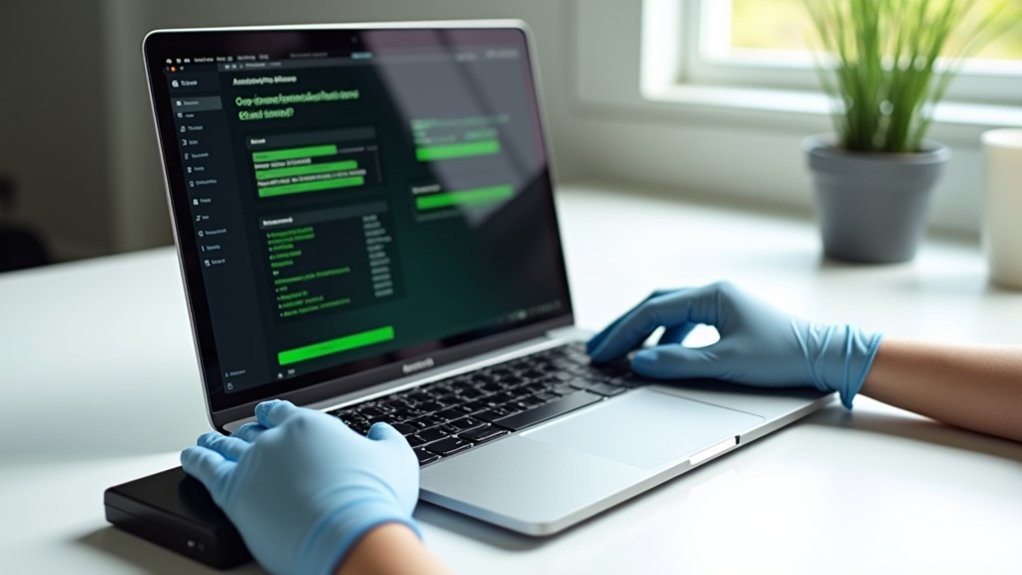
How to reset apple ID password
Unlock your Apple ID with ease—discover the essential steps to reset your forgotten password, but there’s one crucial detail you can’t miss.

If you think your Mac might have a Trojan virus, it’s crucial to act fast to safeguard your data. Understanding how these sneaky threats bypass your defenses and the warning signs to look out for is essential. Before diving into action, familiarize yourself with the safest steps for Trojan virus removal—otherwise, you might worsen the situation. Let’s delve into what actually occurs when a Trojan virus invades your Mac and how to effectively remove it.

Are you aware that even though Macs are renowned for their security, they can still fall prey to trojans?
These sneaky threats can infiltrate your Mac through deceptive downloads, malicious email attachments, or compromised websites.
Once a trojan finds its way onto your device, it masquerades as legitimate software, quietly infiltrating your system.
It might exploit security gaps or trick you into granting permissions, paving the way for hackers to steal your data or even control your Mac remotely.
Stay informed and protect your Mac from trojans to ensure your valuable information remains safe and secure.
Is your Mac acting up? It might be a sign that your Mac has a trojan. Keep an eye out for sudden slowdowns, unexpected pop-ups, or applications launching on their own.
If your browser redirects you to unfamiliar websites or you notice strange login attempts, these are major red flags indicating your Mac might’ve a trojan.
Additionally, increased fan noise, overheating, or files mysteriously changing can also suggest a trojan infection.
Stay vigilant for these signs—they often signal that your Mac has a trojan.
To safely remove a trojan from your Mac, it’s crucial to disconnect from the internet first.
This step helps contain the threat and prevents the malware from communicating with remote servers or spreading further. To disconnect, simply click the Wi-Fi icon in your menu bar and select “Turn Wi-Fi Off.”
If you’re using an Ethernet connection, make sure to unplug the cable. By disconnecting from the internet, you limit the trojan’s ability to cause more harm, ensuring a more secure way to deal with the malware on your Mac.
Unlock the power of built-in Mac security tools to safeguard your device from potential threats like trojans. Macs come with robust features such as XProtect, which operates behind the scenes to scan files for known malware signatures.
Additionally, the Gatekeeper feature plays a crucial role by blocking applications from unidentified developers. To further enhance your Mac’s security, regularly check the Activity Monitor for any suspicious processes that may indicate a threat.
Don’t forget to keep your macOS updated, as Apple consistently rolls out security patches to bolster protection against new and evolving threats.
When it comes to safeguarding your Mac against advanced threats like trojans, relying solely on built-in macOS tools mightn’t be enough.
This is where reputable third-party antivirus software steps in to provide that extra layer of security. Opt for trusted antivirus software that boasts strong detection rates to ensure comprehensive protection.
Make sure to install the latest version of the antivirus software to stay updated with the newest threat definitions. Once installed, run a full system scan with the antivirus software to identify and quarantine any lurking threats.
Follow the antivirus software’s prompts to remove detected trojans and maintain a clean and secure system. By incorporating reliable third-party antivirus software, you can significantly bolster your Mac’s defenses against potential cyber threats.
To maintain your Mac’s security and prevent future Trojan infections, it’s crucial to develop good digital habits.
Regularly updating your macOS and software is a must to patch any vulnerabilities that could be exploited by Trojans. Always download apps from the official App Store or other trusted sources to minimize the risk of Trojan infections.
Be cautious of suspicious links or email attachments that might harbor Trojan threats. Enhance your Mac’s defenses by enabling its built-in firewall, using strong passwords, and routinely backing up your important data.
To safely remove a Trojan virus from your Mac, follow these steps to enhance your device’s security. Staying vigilant against unusual activities and consistently updating your system is crucial. Remember, using trusted antivirus software is one of your best defenses against a Trojan virus. Regularly scan your Mac for threats and be cautious with downloads and email attachments. By adopting these practices, you can protect your device and safeguard your data, ensuring you use your Mac with confidence and peace of mind. Keep your Mac secure from any Trojan virus threats!

Unlock your Apple ID with ease—discover the essential steps to reset your forgotten password, but there’s one crucial detail you can’t miss.

Plagued by malware, your computer could suffer more than you realize—prepare to uncover the unexpected consequences lurking beneath the surface.

Missing these top 5 password mistakes could put your accounts at risk—are you making one without even realizing it?

Discover the subtle clues that your iPhone may be infected and learn why ignoring these 7 signs could put your data at risk.

Thinking your iPhone might be infected with malware? Discover the crucial manual checks you need to perform before your data is at risk.

Just noticed your phone acting strangely? Discover the five warning signs it might be hacked—number three will definitely surprise you.